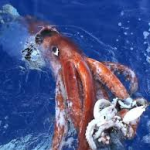(by Marinos Gizas, A class)
The existence of the giant squid is well accepted by science, though few have ever been seen, and little is known about their habits.
Giant squids are carnivorous mollusks that have a long, torpedo-shaped body. At one end, surrounding a beak-like mouth strong enough to cut through steel cable, are five pairs of arms. One pair, thinner and longer than the rest, is used to catch food and bring it to the mouth. Just past the mouth are the eyes – eyes that are the largest in the animal kingdom, sometimes as big as eighteen inches across.
All squid move through the ocean using a jet of water forced out of the body by a siphon. They eat fish, other squid and, in the case of the largest species, whales. They are thought to be open-water, deep, cold-sea creatures, and research indicates the blood of squids does not carry oxygen very well at higher temperatures. A squid will actually suffocate in warm water.
Temperature also seems to affect the squid’s buoyancy mechanism. Warm water will cause a squid to rise to the surface and not be able to get back down. With water temperature ever higher at the surface, the squid may be doomed. Most squid groundings occur near where two ocean streams-one cold, one warm- meet.
The largest squid ever measured was discovered by three fishermen who found a giant squid that had run aground. Using their anchor as a grappling hook, they snagged the still living body and made it fast to a tree. When the tide went out the creature was left high and dry. When the creature died, the fishermen measured it. The body of the squid was twenty feet from tail to beak. The longer tentacles were thirty-five feet and were tipped with four-inch suckers.




